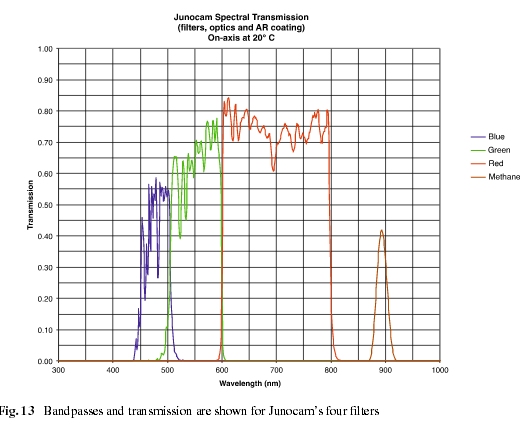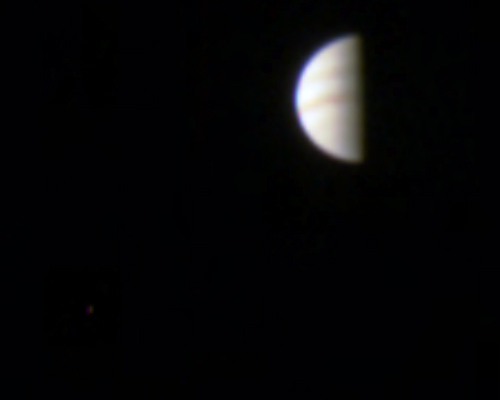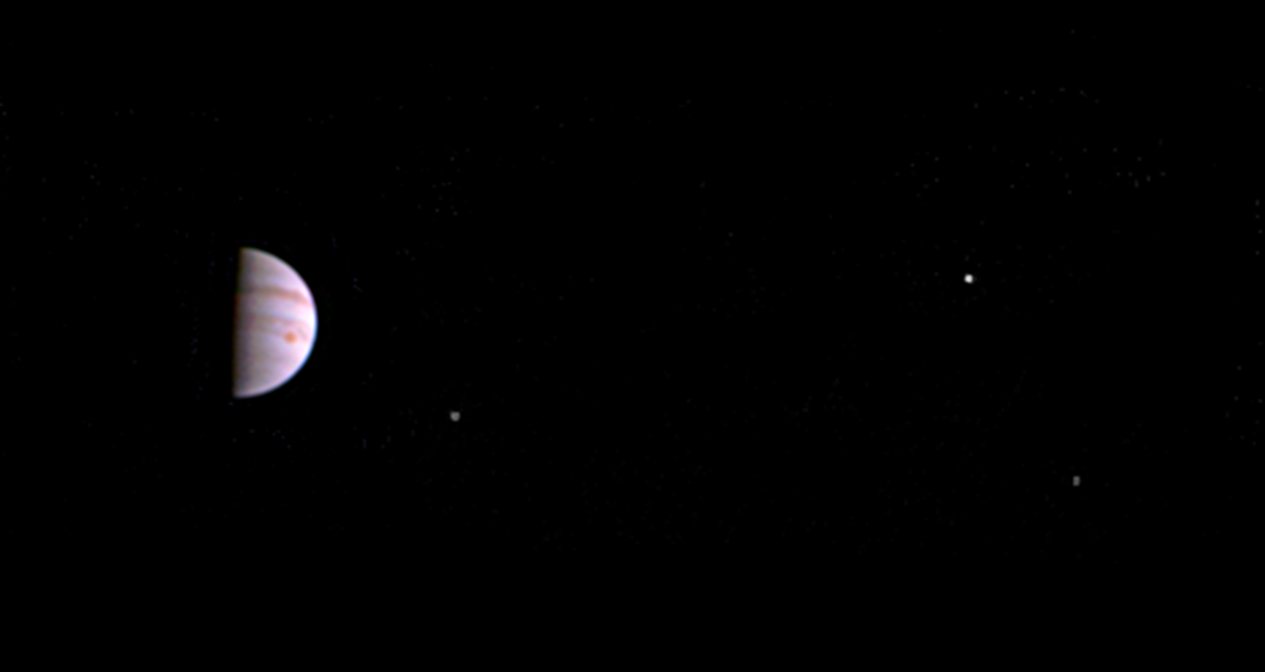It looks like you're using an Ad Blocker.
Please white-list or disable AboveTopSecret.com in your ad-blocking tool.
Thank you.
Some features of ATS will be disabled while you continue to use an ad-blocker.
share:
a reply to: 3danimator2014
Imagine sitting there, with that view, in real time. Seeing the planet rotate. Its bands swirling. And its moons orbiting.
Oh. Sorry. Gary says you would only see darkness. Never mind.
Imagine sitting there, with that view, in real time. Seeing the planet rotate. Its bands swirling. And its moons orbiting.
Oh. Sorry. Gary says you would only see darkness. Never mind.
edit on 7/13/2016 by Phage because: (no reason given)
originally posted by: Deaf Alien
First in-orbit picture. More to come soon. Can't wait
Fantastic image, but of course always better with the original source: www.nasa.gov...
This color view from NASA's Juno spacecraft is made from some of the first images taken by JunoCam after the spacecraft entered orbit around Jupiter on July 5th (UTC). The view shows that JunoCam survived its first pass through Jupiter's extreme radiation environment, and is ready to collect images of the giant planet as Juno begins its mission.
The image was taken on July 10, 2016 at 5:30 UTC, when the spacecraft was 2.7 million miles (4.3 million kilometers) from Jupiter on the outbound leg of its initial 53.5-day capture orbit. The image shows atmospheric features on Jupiter, including the Great Red Spot, and three of Jupiter's four largest moons.
JunoCam will continue to image Jupiter during Juno's capture orbits. The first high-resolution images of the planet will be taken on August 27 when the Juno spacecraft makes its next close pass to Jupiter.
On the topic of JunoCam's resolution, I just saw it stated at the Unmanned Spaceflight Forum that the best resolution of Jupiter we'll see will be 4 km/pixel! Some really, really great images are ahoy.
edit on 13-7-2016 by wildespace because: (no reason
given)
originally posted by: GaryN
originally posted by: 3danimator2014
a reply to: Deaf Alien
Wow..gorgeous image. Thanks for posting. Never seen Jupiter like this before.
Study up on the JUNOCAM. There will be a test in a while.
Search (can't link):
Junocam: Juno’s Outreach Camera
Pray, tell us, what is it about JunoCam that we don't already know, and how does it make "invisible light" visible? The ball is in your court.
Oh wow, just reading up on this mission, the engine is British built
Nice to see we still have some involvement with these deep solar system missions.
Nice to see we still have some involvement with these deep solar system missions.
a reply to: Phage
No, I never said that. I have no doubt that from close range there will be visible light, the question would be as to the source of the light. Is it reflected sunlight, or is it from light generated by UV, or maybe even cosmic ray bombardment of the atmospheric components? The colour filter centre wavelengths have been chosen to match well known emission lines of certain substances, can you identify them? We know the IR filter is for methane.
Oh. Sorry. Gary says you would only see darkness. Never mind.
No, I never said that. I have no doubt that from close range there will be visible light, the question would be as to the source of the light. Is it reflected sunlight, or is it from light generated by UV, or maybe even cosmic ray bombardment of the atmospheric components? The colour filter centre wavelengths have been chosen to match well known emission lines of certain substances, can you identify them? We know the IR filter is for methane.
originally posted by: GaryN
a reply to: Phage
Oh. Sorry. Gary says you would only see darkness. Never mind.
No, I never said that. I have no doubt that from close range there will be visible light, the question would be as to the source of the light. Is it reflected sunlight, or is it from light generated by UV, or maybe even cosmic ray bombardment of the atmospheric components? The colour filter centre wavelengths have been chosen to match well known emission lines of certain substances, can you identify them? We know the IR filter is for methane.
GaryN, with all due respect, I don't want you to argue your case in this thread please. You have your own 40+ thread. Cheers mate. Lets keep it on topic.
Now, about this image. I know it's blurry and I know it's nothing special really but is anyone else here having very strong feelings of awe and emotion looking at it? I am profoundly moved by this beautiful, simple image.
PHAGE: yes..image that beautiful view. The approach time lapse "ballet" video was stunning.
WOOGLEUK: Yes, I read that today too. Very cool.
originally posted by: GaryN
a reply to: Phage
The colour filter centre wavelengths have been chosen to match well known emission lines of certain substances, can you identify them? We know the IR filter is for methane.
But the rest of them (red, green, and blue) are broadband filters: red (600–800 nm), green (500–600 nm), blue (420–520 nm).

source
So whatever argument you wanted to make falls flat again.
(P.S. I'm happy to post about this here because it's a Juno and JunoCam topic)
2 million Rads?
that can not be from the sun?
and they say in the first vid that they use titanium to shiled from it.
I did not think titanium could shiled from radiation?
gold or lead yes.
that can not be from the sun?
and they say in the first vid that they use titanium to shiled from it.
I did not think titanium could shiled from radiation?
gold or lead yes.
originally posted by: Deaf Alien
It might be tomorrow. I'm impatient too.
What might be tomorrow?
Juno is currently performing what is called "capture orbits".
A few days after the JOI Burn, Juno performs a Clean-Up Maneuver to target the time and location of the large Period Reduction Maneuver that is made after the Capture Orbit is complete.
During the long initial Orbit around the Gas Giant, Instruments are turned back on after Jupiter Orbit Insertion. About 50 hours after JOI, all instruments are planned to be powered up and start gathering science data.
As with Jupiter Approach, the duration of the Capture Orbits is utilized to perform more instrument calibration in the Jupiter environment and to obtain initial science data. Teams have sufficient time to learn about instrument and spacecraft behavior during the Capture Orbits so that no additional time is needed when the science phase begins.
spaceflight101.com...
As part of this, on July 13th, Juno performed a "cleanup" orbit-trim maneuver (OTM), and the mission control are now looking at how well that went, which will determine whether Juno will require another OTM on July 27th.
edit on 15-7-2016 by wildespace because: (no reason given)
originally posted by: wildespace
originally posted by: Deaf Alien
It might be tomorrow. I'm impatient too.
What might be tomorrow?
Juno is currently performing what is called "capture orbits".
A few days after the JOI Burn, Juno performs a Clean-Up Maneuver to target the time and location of the large Period Reduction Maneuver that is made after the Capture Orbit is complete.
During the long initial Orbit around the Gas Giant, Instruments are turned back on after Jupiter Orbit Insertion. About 50 hours after JOI, all instruments are planned to be powered up and start gathering science data.
As with Jupiter Approach, the duration of the Capture Orbits is utilized to perform more instrument calibration in the Jupiter environment and to obtain initial science data. Teams have sufficient time to learn about instrument and spacecraft behavior during the Capture Orbits so that no additional time is needed when the science phase begins.
spaceflight101.com...
As part of this, on July 13th, Juno performed a "cleanup" orbit-trim maneuver (OTM), and the mission control are now looking at how well that went, which will determine whether Juno will require another OTM on July 27th.
God, why cant they just flick everything on and start taking pictures? Jeez...Do they have to be SO meticulous with everything they do?
Joke
No new images or info really but here is an interesting article on the mission
www.inverse.com...
www.inverse.com...
What the hell is Jupiter made of? Lunine and his colleagues are interested in learning exactly what about the composition of the planet because it is likely also “the composition of the building blocks of all the planets of the solar system, including material that may have delivered water to Earth.” “This,” says Lunine, “is kind of the cosmic archeology part.”
Thanks to the Juno twitter feed, i can point you to this link for all the raw images from the approach to Jupter
www.missionjuno.swri.edu...
Twitter feed:
twitter.com...
www.missionjuno.swri.edu...
Twitter feed:
twitter.com...
Actually, i just got a chance to finish the article above and i can highly recommend it folks. Lots of info on Jup and Saturn
One guy at the Unmanned Spaceflight Forum created a timelapse of Juno's approach to Jupiter:
www.unmannedspaceflight.com...
I've uploaded it to Youtube for easy viewing:
www.youtube.com...
You can just about make out the Galilean moons spinning around it.
I've uploaded it to Youtube for easy viewing:
www.youtube.com...
You can just about make out the Galilean moons spinning around it.
One of the images from the approach phase, created by Gerald from the
UMSF forum, and colour-balanced by me:

Also, today Juno reached the furthest point in the first of its two "capture orbits" around Jupiter.
www.missionjuno.swri.edu...

Not long left now, and in less than a month we'll get some stunning close-up images!

Also, today Juno reached the furthest point in the first of its two "capture orbits" around Jupiter.
Five years after departing Earth, and a month after slipping into orbit around Jupiter, NASA's Juno spacecraft is nearing a turning point. On July 31 at 12:41 p.m. PDT (3:41 p.m. EDT), Juno will reach the farthest point in its orbit of Jupiter for the first time, known as “apojove,” 5 million miles (8.1 million kilometers) from the giant planet. After that point, Jupiter's gravitational grip on Juno will cause the spacecraft to begin falling back toward the planet for another pass, this time with its scientific eyes wide open.
www.missionjuno.swri.edu...

Following the capture orbits, Juno will fire its engine once more to shorten its orbital period to 14 days and begin its science mission.
But before that happens, on Aug. 27, Juno must finish its first lap around Jupiter, with a finish line that represents the mission's closest pass over the gas giant. During the encounter, Juno will skim past Jupiter at a mere 2,600 miles (4,200 kilometers) above the cloud tops.
Not long left now, and in less than a month we'll get some stunning close-up images!
edit on 31-7-2016 by wildespace because: (no reason
given)
new topics
-
Electrical tricks for saving money
Education and Media: 2 hours ago -
VP's Secret Service agent brawls with other agents at Andrews
Mainstream News: 4 hours ago -
Sunak spinning the sickness figures
Other Current Events: 4 hours ago -
Nearly 70% Of Americans Want Talks To End War In Ukraine
Political Issues: 4 hours ago -
Late Night with the Devil - a really good unusual modern horror film.
Movies: 6 hours ago -
Cats Used as Live Bait to Train Ferocious Pitbulls in Illegal NYC Dogfighting
Social Issues and Civil Unrest: 8 hours ago -
The Good News According to Jesus - Episode 1
Religion, Faith, And Theology: 9 hours ago
top topics
-
Cats Used as Live Bait to Train Ferocious Pitbulls in Illegal NYC Dogfighting
Social Issues and Civil Unrest: 8 hours ago, 8 flags -
Florida man's trip overseas ends in shock over $143,000 T-Mobile phone bill
Social Issues and Civil Unrest: 14 hours ago, 8 flags -
VP's Secret Service agent brawls with other agents at Andrews
Mainstream News: 4 hours ago, 8 flags -
Former Labour minister Frank Field dies aged 81
People: 17 hours ago, 4 flags -
HORRIBLE !! Russian Soldier Drinking Own Urine To Survive In Battle
World War Three: 12 hours ago, 3 flags -
Nearly 70% Of Americans Want Talks To End War In Ukraine
Political Issues: 4 hours ago, 3 flags -
Sunak spinning the sickness figures
Other Current Events: 4 hours ago, 3 flags -
Bobiverse
Fantasy & Science Fiction: 14 hours ago, 3 flags -
Electrical tricks for saving money
Education and Media: 2 hours ago, 3 flags -
Late Night with the Devil - a really good unusual modern horror film.
Movies: 6 hours ago, 2 flags
active topics
-
Why to avoid TikTok
Education and Media • 19 • : Kaiju666 -
President BIDEN Vows to Make Americans Pay More Federal Taxes in 2025 - Political Suicide.
2024 Elections • 133 • : 5thHead -
HORRIBLE !! Russian Soldier Drinking Own Urine To Survive In Battle
World War Three • 30 • : DaRAGE -
Spectrophilia - Women Who Have Had Affairs With Ghosts Say Spooks Are Better Lovers Than Real Men
Paranormal Studies • 32 • : burritocat -
Electrical tricks for saving money
Education and Media • 2 • : rickymouse -
-@TH3WH17ERABB17- -Q- ---TIME TO SHOW THE WORLD--- -Part- --44--
Dissecting Disinformation • 656 • : burritocat -
Cats Used as Live Bait to Train Ferocious Pitbulls in Illegal NYC Dogfighting
Social Issues and Civil Unrest • 18 • : Xtrozero -
VP's Secret Service agent brawls with other agents at Andrews
Mainstream News • 29 • : WeMustCare -
VirginOfGrand says hello
Introductions • 6 • : TheMichiganSwampBuck -
How ageing is" immune deficiency"
Medical Issues & Conspiracies • 31 • : rickymouse

